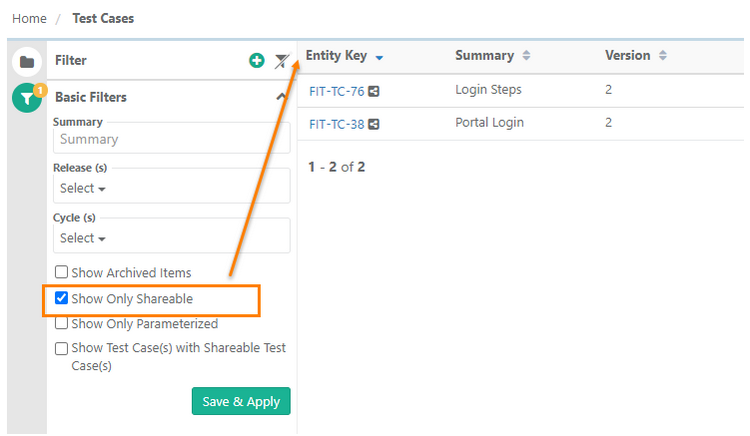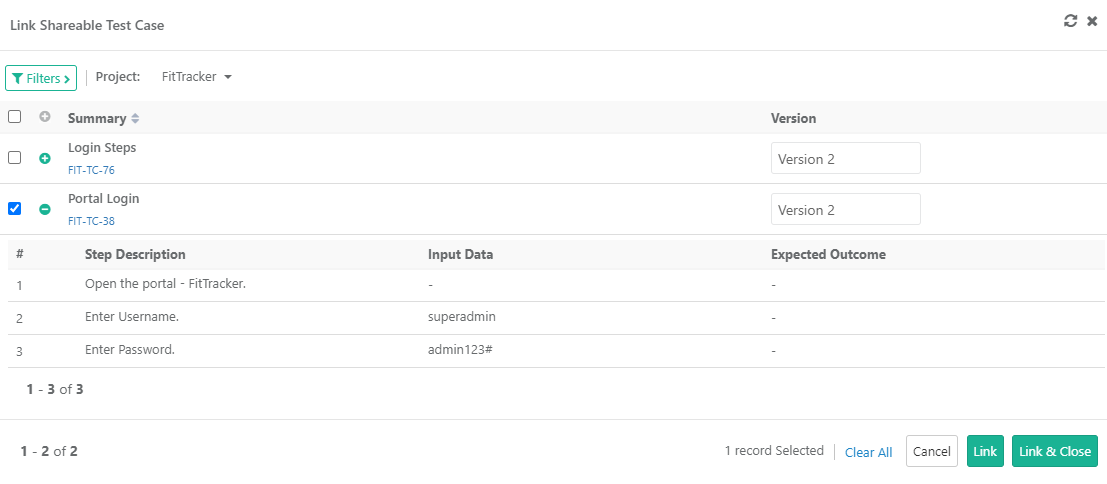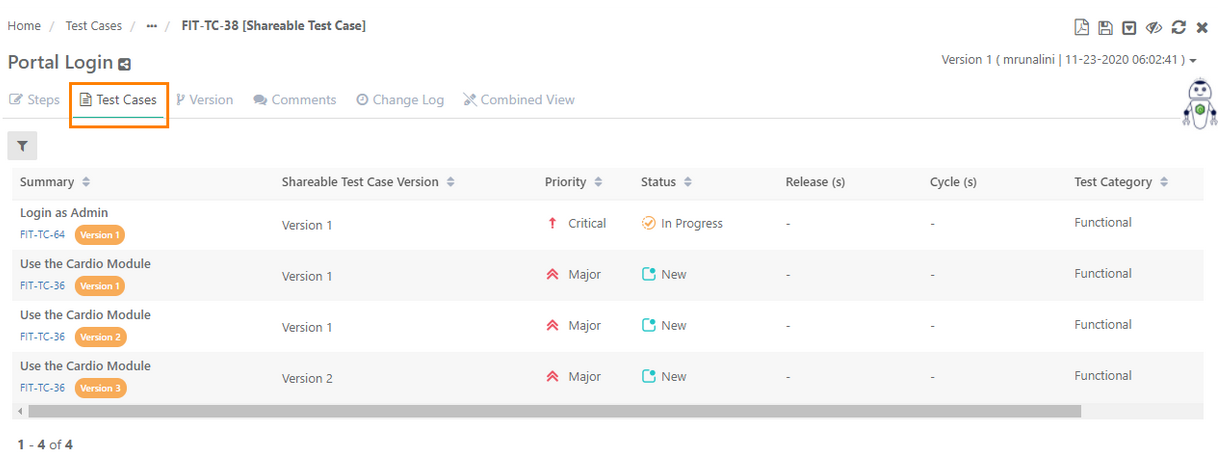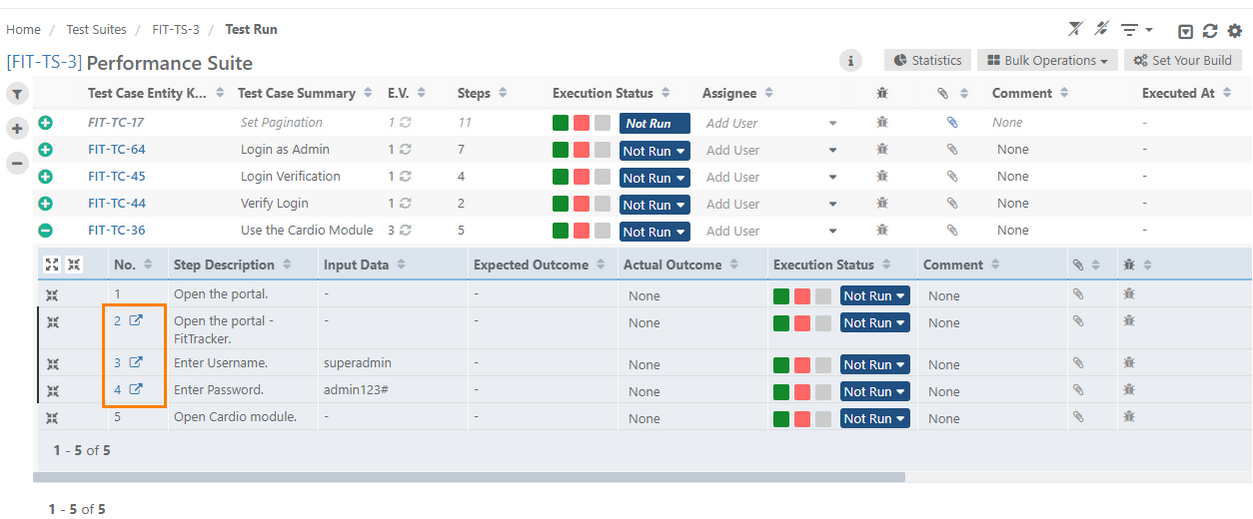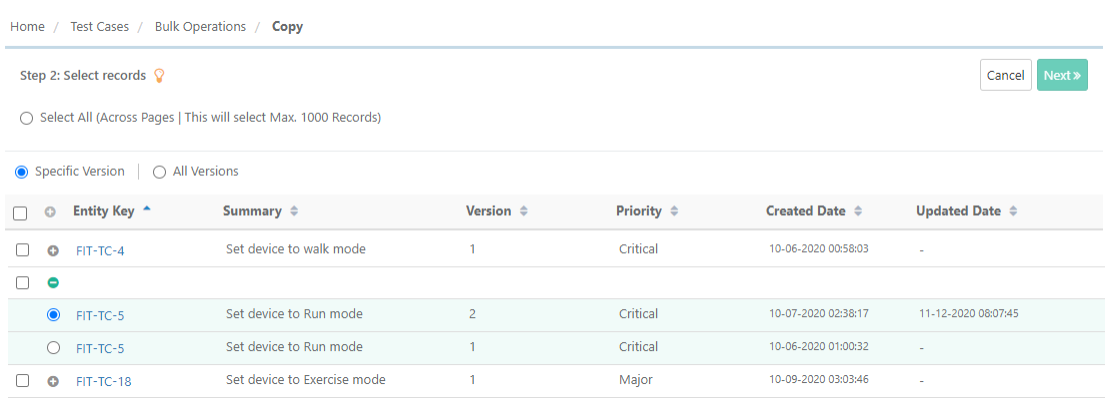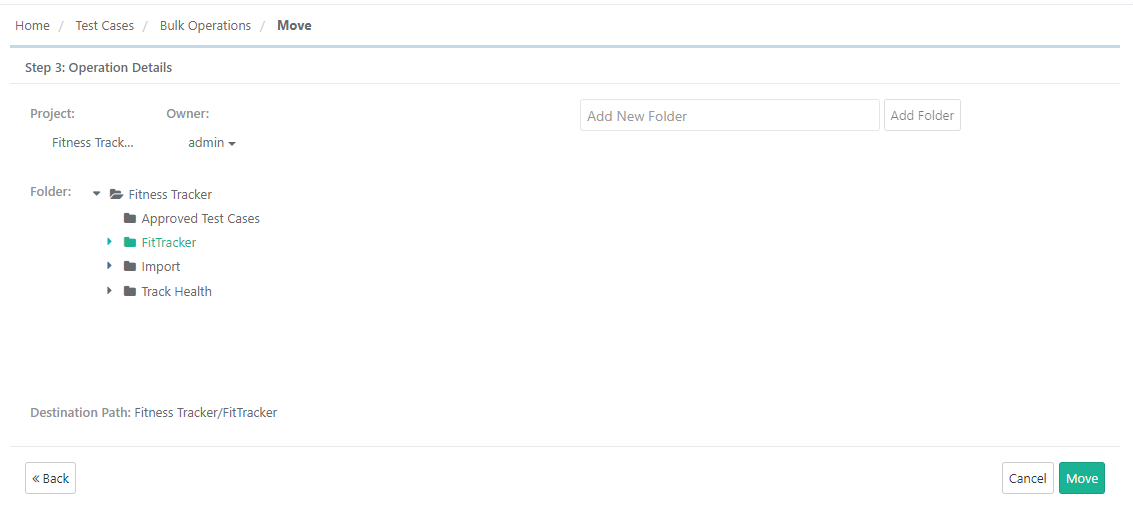...
...
...
...
...
...
...
...
...
...
...
...
...
...
...
...
...
...
...
...
...
...
...
...
...
...
...
...
...
...
...
...
...
...
...
...
...
...
| Table of Contents | ||
|---|---|---|
|
Overview of Test Case Sharing
QMetry Test Management encourages users to maximize efficiency in managing testtests. It provides different ways to reuse test cases, which saves the time of testers and makes information maintenance easier for testers. The following is a summary of the options that users can use in the same project.
Reusing Shareable Test Cases: Shareable Test
...
cases are set of "Shareable Steps" that can be reused in other Test cases.
Copying Test Steps: Create a duplicate copy of step into the same test case. This is a one-time copy and paste of test steps.
Copying Test Cases: A one-time copy and paste of bulk test case(s). The test cases can be pasted into the same project and across projects.
Moving Test Cases: The test cases can be moved into the same project and across projects.
Shareable Test Cases
QMetry allows you to create Shareable Test Cases and reuse these Shareable Test Cases into another test case, i.e. reusing test cases. A shareable test case is used in different other tests within the same project to avoid creation of repeated test steps across test cases.
...
The shareable test case functionality is beneficial as it:
Saves Time: The common test steps are added into a single test case instead of entering the repeated test steps into every test case.
Maintains Consistency: If the test steps need to be updated, then you can update the shareable test case in a single place. All other test cases that use the common test steps can have the updated information by using the updated version of the shareable test case.
Create Shareable Test Cases
In this example, we will show you how to add shareable test case and then reuse it in another test case. You can create shareable test cases using existing test steps.
Once you create a test case with test steps, open the test case details page.
Go to the Test Steps section.
...
Note: The Create Shareable Test Case button is available only on test case details page.
...
The Create Shareable Test Case pop-up opens. Enter Summary/Name of the shareable test case that is being created and click Create. The shareable test case is created.
...
3. Click on the refresh icon to sync the latest version of the shareable test case.
...
4. The shareable test case version is updated as per the latest version. Click Update to save the changes.
...
View Shareable Test Cases
...
The shareable test case is identified by its distinct icon.
...
To open the test case details page, click on the Entity Key of the shareable test case.
...
Reuse Shareable Test Cases
...
To insert the shareable test case in the next row, click on the cog icon on the individual test step and select Insert Shareable Test Case.
...
3. The Link Shareable Test Case pop-up opens. Select the test case you want to link to the new test case. You can also select a particular version of the test case.
4. Click either on Link or on Link & Close button. Clicking on the Link button will keep the window open after linking test cases. Clicking on the Link & Close button will close the window after linking test cases.
...
The shareable test cases are added to another test case. On the Steps tab, you can view the test case Key and version that has been linked.
...
B. Open the shareable test case in a separate tab.
...
View Test Cases Linked to a Shareable Test Case
On the shareable test case detail page, open the the Test Case tab tab. The tab lists all the test cases in which the current shareable test case is linked.
Use Case: A A shareable test case is updated, but testers do not know which test cases will be impacted due to this change. Hence, the Test Case tab is added to help testers see the test cases in which shareable test cases are used.
...
View Test Cases having Shareable Test Case
The Show Test Cases with Shareable Test Case filter is added on to the test case tree to let users see users see test cases to which shareable test cases are linked into it.
Use Case: Testers Testers want a quick way to see test cases that contain shareable test cases linked to them. The filter allows users to get such a list of test cases promptly instead of checking individual test cases for the shareable test cases attached to them.
...
Easily Identify Steps from Shared Test Cases
On the Test Execution screen, you can view the Shareable Step details. The Shareable Steps can be identified by the icon to open it in a separate tab. On hovering the icon, it displays the Entity Key for the test step. When you run a test, you can either mark the whole test case as passed or failed , or mark each step individually.
...
Copying Test Steps
QMetry allows you to copy and paste test steps within the same test case.
Copy / Paste test steps within the same test case
Go to the Test Steps section and click Edit. You can now view '+' icon and cog icon for steps.
...
Click on the Con icon for the step that you want to create a copy of
...
, and select Duplicate Row.
It will create a copy of the existing step and add it to the test steps.
...
Copying Bulk Test Cases
Users Users can copy test cases into the same project or across projectprojects. This function works as a one-time copy so that the duplicate sets of test case(s) act independently going forward. In other words, after the copy and paste, any changes performed on the original test case will not be reflected in the test case's copy.
Pre-requisite: The destination project should have the required user-defined fields that are used in the source project.
Test Cases can be copied to the destination folder or a the root folder of the destination project.
What will be copied with test assets?
Operation | Same Project | Across Project |
|---|---|---|
Copy | For the selected /all versions it will copy assets with all attachments, linkage of requirements, test cases, release, cycle , issues (linked with Requirement ) | For the selected/all versions it will copy assets with all attachments |
To copy test cases from one project to another project or the same project, perform the following steps.
Select the project from which you will copy a test case. Go to the Test Cases module, click on the Con icon, and select Bulk Operations.
...
Step 1 Choose Operation: Select Copy as the operation to perform and click Next.
...
Step 2 Select records
...
2. Select test case version options:
Specific Version: Test Cases in the grid appear expandable when this option is selected. On expanding test case, you can view all the available versions for the test case.
All Versions: if this option is selected, then the Version button is disabled. Users can not select a particular version of the test case.
3. Click Next.
...
Step 3 Operation Details
Project: You can copy test cases within the same project and across projects. Select the destination Project/folder path you want to copy the
selectedselected test cases to.
Owner: If the test cases are being copied to another project, then you can select the Owner of the test cases in the destination project. The Owner list is populated as per the Project selection above.
Folder: Select the folder in which you want to copy the selected test cases. The Destination Path is displayed according to the Folder selection.
...
Click Copy.
The confirmation message appears.
Moving Bulk Test Cases
The process is same as Bulk Copy except the version selection. Test Assets will be moved with all its existing versions.
...
What will be copied/moved with test assets?
Operation | Same Project | Across Project |
|---|---|---|
Move | For the selected /all versions it will copy assets with all attachments, linkage of requirements, test cases, release, cycle , issues (linked with Requirement ) | For the selected/all versions it will move assets with all attachments |
To move test cases from one project to another project or same project, perform the following steps.
Select the project from which you will move a test case. Go to the Test Cases module, click on the Con icon and select Bulk Operations.
...
Step 1 Choose Operation: Select Move as the operation to perform and click Next.
...
2. Select test cases and click Next.
Step 3 Operation Details
Project: You can copy test cases within same project and across projects. Select the destination Project/folder path you want to copy the selected test cases to.
Owner: If the test cases are being copied to another project, then you can select Owner of the test cases in the destination project. The Owner list is populated as per the Project selection above.
Folder: Select the folder in which you want to copy the selected test cases. The Destination Path is displayed according to the Folder selection.
Click Move.
...
The confirmation message appears.
Test Data Parametrization in Shareable Test Cases
You can create shareable test cases from steps that contain data parameters. You can also insert parameterized shareable test case into the existing test case. At the time of execution, the parameter values for this shareable test case will be referred from the main test case that is using it.
Use Case: QA team is creating and maintaining test data-driven test cases, therefore, they want their shareable test cases parameterized as well.
Notes:
Shareable test cases with parameters can be inserted into a test case.
If you go to edit a parameterized shareable test case, which is already associated with a test case and is part of execution, then it will be saved with a new version.
While copying and moving parameterized shareable test cases, if the parameters of the test cases do not exist in the destination project, then those parameters will be created in the destination project.
Parameterized shareable test cases can be used cross projects. If the parameters do not exist in the project, then those parameters will be created in the project.
Test cases containing parameterized steps along with the normal steps can be executed.
Shareable parameterized test cases, which are linked with execution can not be deleted.
Create shareable test case from parameterized steps
1. Open the test case which contains parameterized steps in it.
2. Select the parameterized steps you want to include in the shareable test case and click on the Create Shareable Test Case button.
...
The Create New Shareable Test Case pop-up opens.
3. Enter Name of the shareable test case and click Create.
...
On the test case list view, apply the filter to view only Shareable and the shareable test cases will be listed on the screen.
...
Open the shareable test case detail page.
The shareable test case created from parameterized steps is displayed like below.
...
Inserting Parameterized Shareable Steps
You can insert a parameterized shareable step from the current project as well as from other projects.
Steps
1. Open the test case detail page.
2. Go to the Steps tab.
3. Open the cog icon and click on the Insert Shareable Test Case.
...
The Link Shareable Test Case pop-up opens.
You can also insert a parameterized shareable test case from other projects.
If the parameters of a parameterized shareable test case do not exist in the current project, then the parameters will get created in the project once the shareable test case is linked.
4. Select the shareable test case(s) you want to link and click Link.
...
The test case in example has its own normal steps and parameterized steps. And now, parameterized shareable test steps are linked to it.
...
Mapping Data Grid for Test Cases
To insert values in the parameterized shareable test steps, you need to map the data grid with the test case.
Steps
1. Link the main test case, which contains parameterized shareable steps, to a test suite.
2. Open the test suite details page.
3. Go to the Test Cases tab in the test suite.
4. Click on the Link Parameter Values sign @ to add values to the parameters for the test case which contains the shareable test steps.
You can see that the @ sign for parameterization is highlighted and has a hyperlink on it.
...
The Mapping DataGrid screen opens.
...
5. Select either of the following as Data Source:
Select DataGrid: Select the option if you want to opt for the Data Grid created under the Data Parameterization module.
Data Grid: The drop-down displays all the Data Grids created under the Data Parameterization module. The data is populated in the below table as per the grid selection.
Fill Data Manually: Select the option if you want to enter the parameter values manually. Map values with corresponding parameters.
6. Click Save to save the entered data.
...
Execute Parameterized Test Cases
You can execute the parameterized shareable test steps. The values in the steps will get replaced as per the mapping of grid data for the test case.
Steps
1. Open the test suite detail page.
2. Open the Test Execution tab on it.
3. Click on the play icon to navigate to the Test Execution Screen to execute the parameterized test case.
...
On the Test Execution Screen, when you click on the Expand All button, the test cases with parameterization get expanded up to Parameter Groups.
The steps count at the test case level displays (the count of test steps X count of data sets).
4. Expand each Parameter Combination to view the test steps under it.
The parameter values for shareable steps are displayed as per the data grid mapping done for the main test case using the shareable steps.
If the normal steps have parameters, their values also get replaced as per the data grid mapping of the test case.
...


